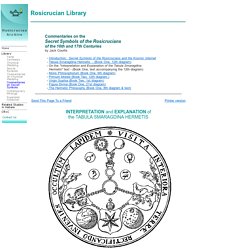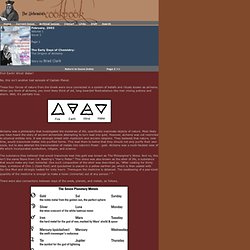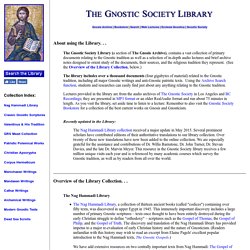

Secret Symbols of the Rosicrucians - TABULA SMARAGDINA HERMETIS - Explanation. This picture, plain and insignificant in appearance, Concealeth a great and important thing.

Yea, it containeth a secret of the kind That is the greatest treasure in the world. For what on this earth is deemed more excellent Than to be a Lord who ever reeketh with gold, And hath also a healthy body, Fresh and hale all his life long, Until the predestined time That cannot be overstepped by any creature. "This picture", is the diagram above. It is very far from plain and insignificant as we have seen from the previous article on the Emerald Tablet. It conceals and contains a great and important secret because mere words cannot describe or explain it. All this, as I have stated, clearly Is contained within this figure. These are the three alchemical principles of Mercury, Sulfur and Salt. And painted in their very midst Artfully stands an imperial globe.
The imperial globe is the alchemical symbol for VITRIOL. The hands are another symbol of duality. Alchemy. The Alchemist's Cookbook. Fire!

Earth! Wind! Water! No, this isn't another bad episode of Captain Planet. These four forces of nature from the Greek were once connected in a system of beliefs and rituals known as alchemy. Alchemy was a philosophy that investigated the mysteries of life, specifically inanimate objects of nature. The substance they believed that would transmute lead into gold was known as The Philosopher's Stone. There were also connections between days of the week, planets, and metals, as follows, The days of the week were named after the planets: Sunday for the Sun, Monday for "mooneday" (old English), Tuesday for Tyr (Mars), Wednesday for Woden (or Odin, Mercury), Thursday for Thor (Jupiter), Friday for Frigga (wife of Mercury), and Saturday for Saturn.
Accordingly, different chemicals processes were associated with the 12 signs of the zodiac, Alchemists also used images of serpents. A three-headed serpent represented the Philosopher's Stone. References: 1. 2. Manuscript. Main_collage2_ir_ The Alchemy Web Site. The Alchemy Web Site. Ancient Egypt Online. Mystical Keys to the Tree of Life and Tarot.
The Hermetic Library at Hermetic.com. Gnostic Society Library: Sources on Gnosticism and Gnosis. Almost all of the several dozen internet sites with collections of texts similar to our own obtained their material by directly or indirectly copying some files present at the Gnosis Archive.

Ours was perhaps the first major collection of such texts to appear on "the web" in 1994, and thus has served as a source for others creating "their own" collections. Unfortunately transcription errors, typos, and primitive HTML formatting were present in the massive amount of material added to the Gnosis Archive in our first years; in a repeated process of "copying" they have been very widely propagated around the internet.
Over nearly two decades we have made many corrections to these texts. It appears that few of the sites copying material from this collection have taken the time to read, edit and correct the texts! Satkona - Star of David or Star of Goloka? The Star of David [in Hebrew, the Magen David or Shield of David] is renowned as the sacred symbol of the Jewish faith.

Indeed, the Star of David is the distinguishing feature on the Israeli flag and as an ornament of jewelry the Star of David is proudly worn by millions of devout Jews worldwide. Yes, the Star of David is purely Jewish. Or is it? Recently, while visiting the holy city of Jerusalem, I purchased a silver pendant of the “Star of David” from a local shopkeeper and when I put it around my neck I was asked: “Why are you wearing a Jewish symbol?” To this I replied: ”This is Sat-kona, the symbol of Goloka, the abode of Krsna.” This article is about the origins of Sat-kona [the Star of Goloka or Goloka-yantra], its transcendental significance, its historical use in Vedic and other ancient cultures, its use in Christianity and Islam, and its eventual adoption by the Jewish faith in the 17th century as a popular symbol of Judaism.